Abstract
The neural cell adhesion molecule (N-CAM) has an unusually high amount of sialic acid (28-35 g/100 g of polypeptide) and shows microheterogeneity in electrophoretic gels in its embryonic or E form. During development, the molecule undergoes conversion to several adult or A forms, which resemble the E form but which on the average have only 10% sialic acid and do not appear to be microheterogeneous. In the present study, rabbit antibodies to mouse N-CAM and two different monoclonal antibodies were used to follow the E leads to A conversion in normal and mutant mice. E leads to A conversion to three forms (Mr 180,000, Mr 140,000, and Mr 120,000) was found to occur at different rates in different parts of the brains of wild-type mice. Examination of the entire cerebellum of the granuloprival mouse mutant staggerer (sg/sg) showed that the E leads to A conversion did not occur by 21 days after birth, whereas in wild type it was almost complete at that time. There was also some delay in E leads to A conversion within the cerebral cortex of sg/sg, although phenotypically no evidence of cortical disorder has been detected. In pooled tissues from phenotypically normal-appearing littermates, (i.e., a mixture of sg/+ and +/+), a slight conversion delay was also found in cerebellum and cortex. The mutants weaver, reeler, and jimpy all showed normal schedules of E leads to A conversion. These observations raise the possibility that a major defect in staggerer mutants relates to a failure in local surface modulation of N-CAM to produce the A forms of the molecule. Some of the failures of synapse formation and of cell survival seen in this disease may result from the anomaly, which is likely to alter the binding properties of N-CAM at critical times of development.
Full text
PDF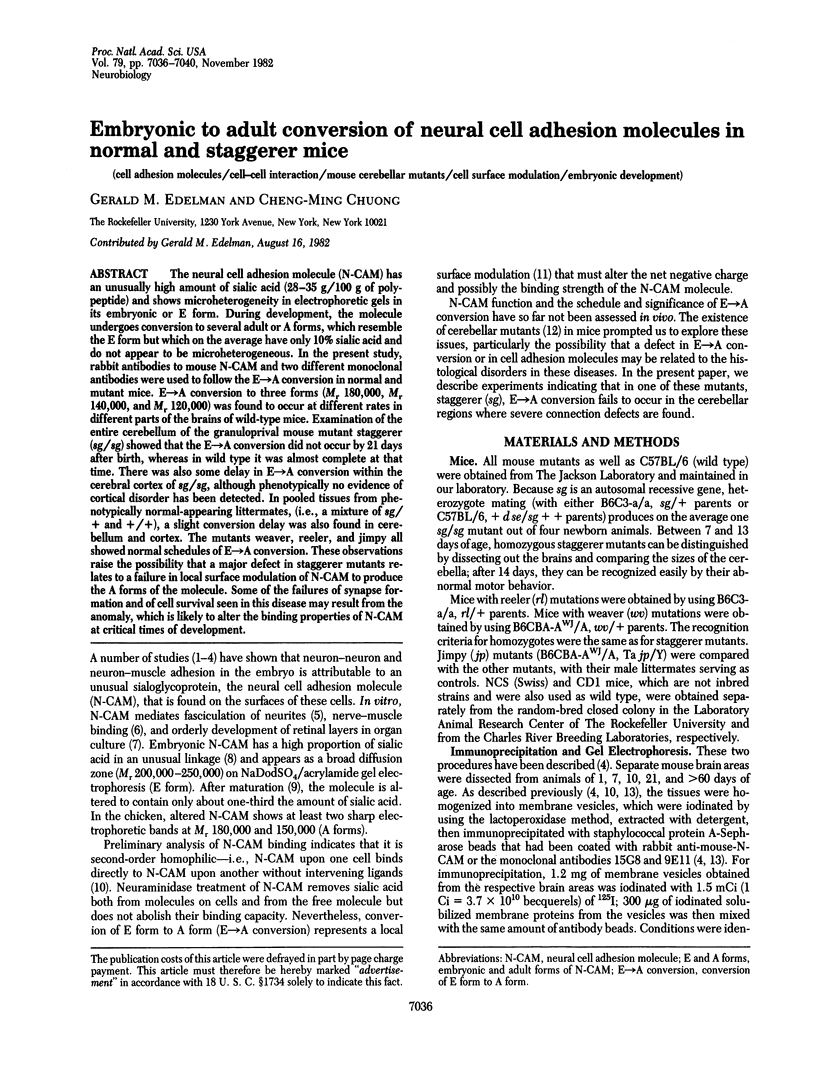
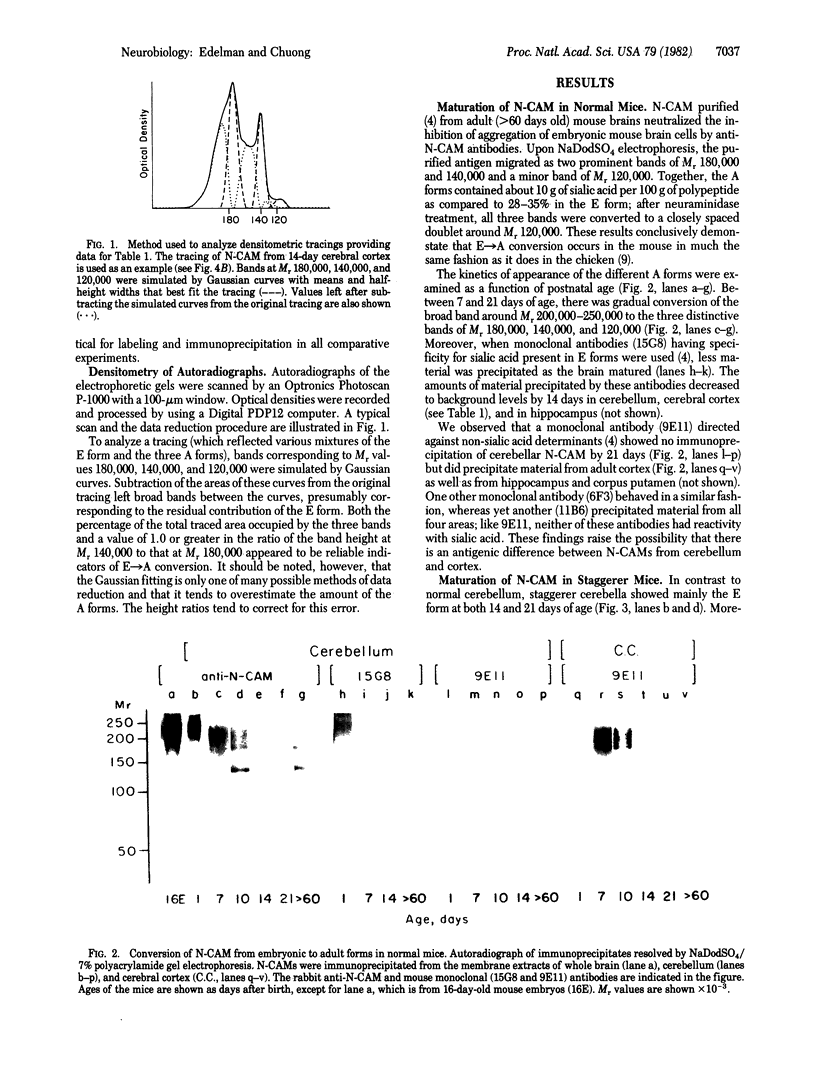
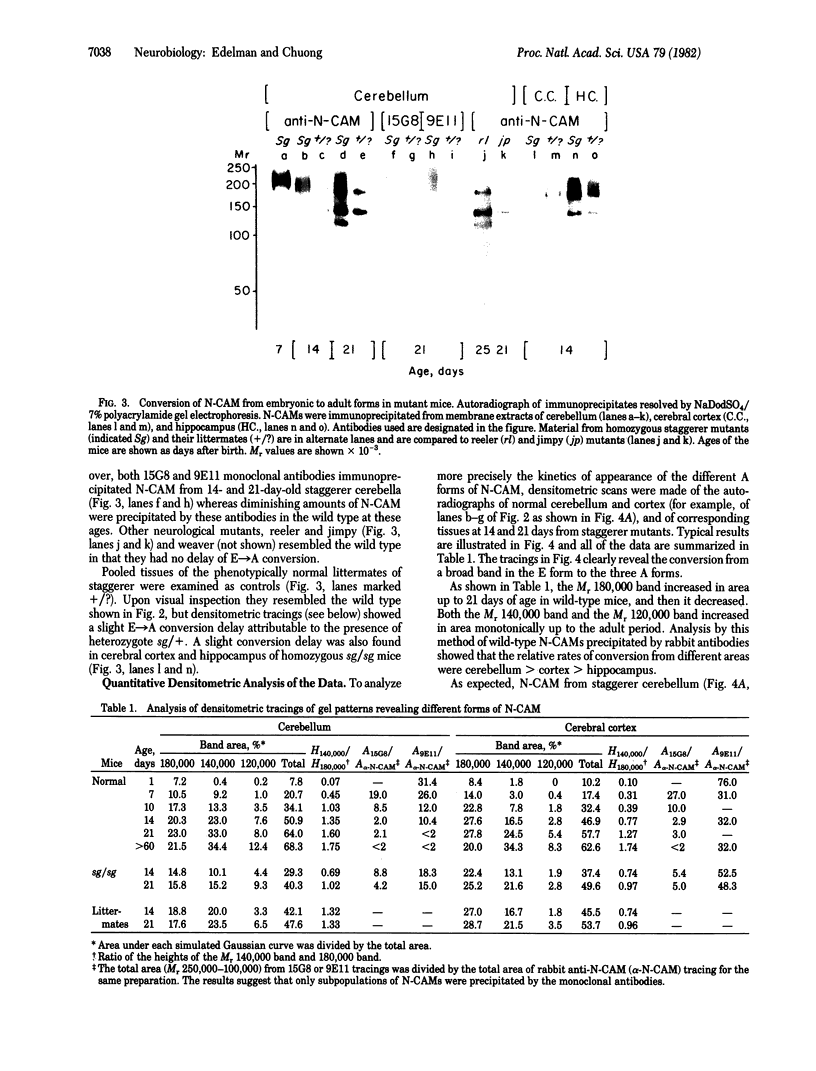
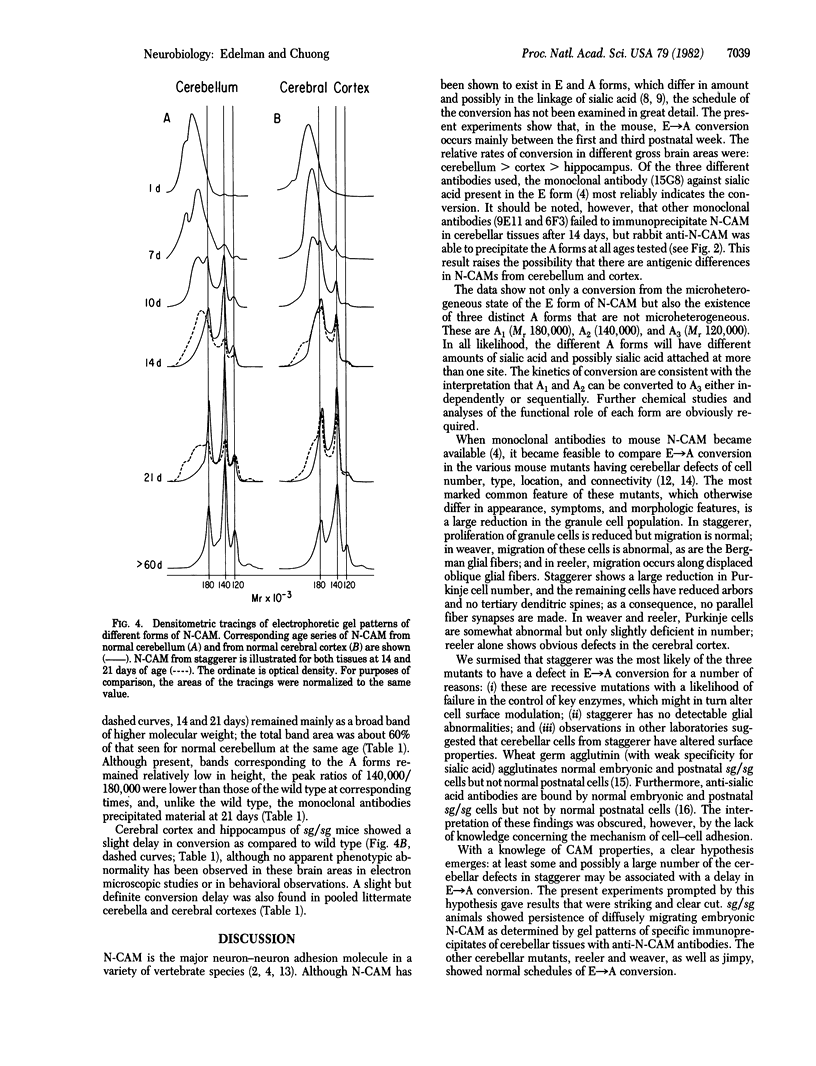
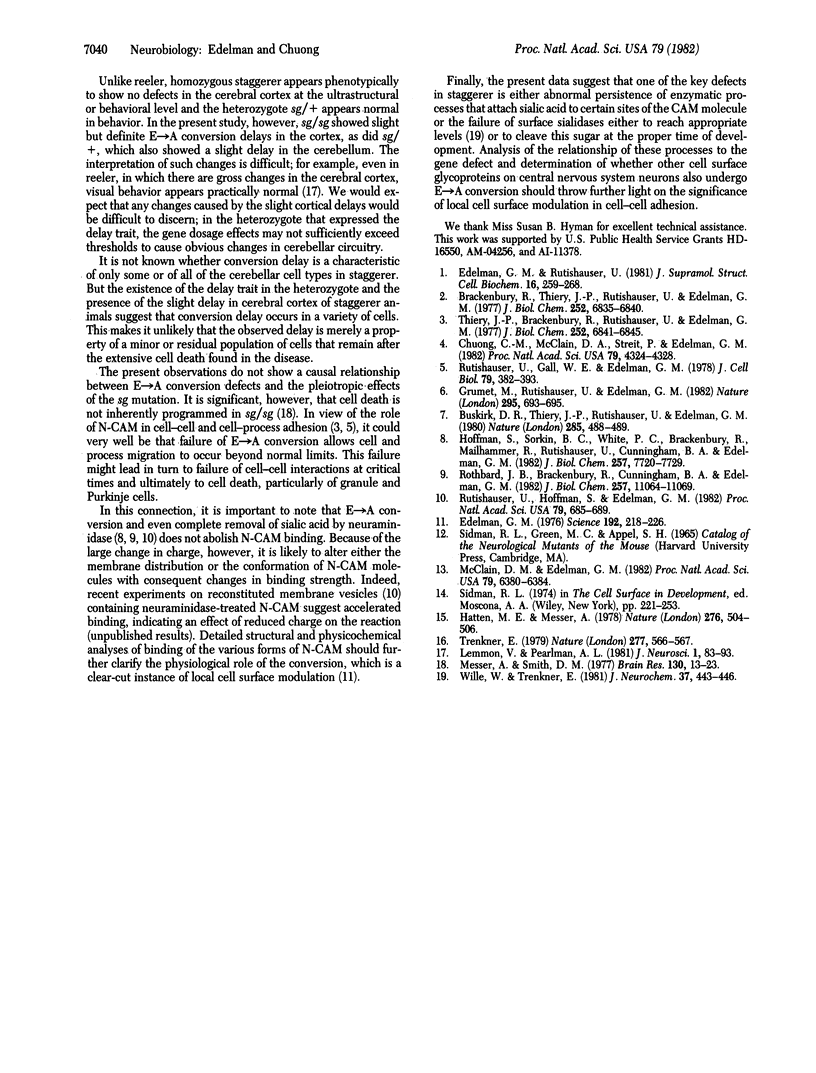
Images in this article
Selected References
These references are in PubMed. This may not be the complete list of references from this article.
- Brackenbury R., Thiery J. P., Rutishauser U., Edelman G. M. Adhesion among neural cells of the chick embryo. I. An immunological assay for molecules involved in cell-cell binding. J Biol Chem. 1977 Oct 10;252(19):6835–6840. [PubMed] [Google Scholar]
- Buskirk D. R., Thiery J. P., Rutishauser U., Edelman G. M. Antibodies to a neural cell adhesion molecule disrupt histogenesis in cultured chick retinae. Nature. 1980 Jun 12;285(5765):488–489. doi: 10.1038/285488a0. [DOI] [PubMed] [Google Scholar]
- Edelman G. M., Rutishauser U. Molecules involved in cell--cell adhesion during development. J Supramol Struct Cell Biochem. 1981;16(3):259–268. doi: 10.1002/jsscb.1981.380160306. [DOI] [PubMed] [Google Scholar]
- Edelman G. M. Surface modulation in cell recognition and cell growth. Science. 1976 Apr 16;192(4236):218–226. doi: 10.1126/science.769162. [DOI] [PubMed] [Google Scholar]
- Grumet M., Rutishauser U., Edelman G. M. Neural cell adhesion molecule is on embryonic muscle cells and mediates adhesion to nerve cells in vitro. Nature. 1982 Feb 25;295(5851):693–695. doi: 10.1038/295693a0. [DOI] [PubMed] [Google Scholar]
- Hatten M. E., Messer A. Postnatal cerebellar cells from staggerer mutant mice express embryonic cell surface characteristic. Nature. 1978 Nov 30;276(5687):504–506. doi: 10.1038/276504a0. [DOI] [PubMed] [Google Scholar]
- Hoffman S., Sorkin B. C., White P. C., Brackenbury R., Mailhammer R., Rutishauser U., Cunningham B. A., Edelman G. M. Chemical characterization of a neural cell adhesion molecule purified from embryonic brain membranes. J Biol Chem. 1982 Jul 10;257(13):7720–7729. [PubMed] [Google Scholar]
- Lemmon V., Pearlman A. L. Does laminar position determine the receptive field properties of cortical neurons? A study of corticotectal cells in area 17 of the normal mouse and the reeler mutant. J Neurosci. 1981 Jan;1(1):83–93. doi: 10.1523/JNEUROSCI.01-01-00083.1981. [DOI] [PMC free article] [PubMed] [Google Scholar]
- McClain D. A., Edelman G. M. A neural cell adhesion molecule from human brain. Proc Natl Acad Sci U S A. 1982 Oct;79(20):6380–6384. doi: 10.1073/pnas.79.20.6380. [DOI] [PMC free article] [PubMed] [Google Scholar]
- Messer A., Smith D. M. In vitro behavior of granule cells from Staggerer and Weaver mutants of mice. Brain Res. 1977 Jul 8;130(1):13–23. doi: 10.1016/0006-8993(77)90839-3. [DOI] [PubMed] [Google Scholar]
- Rothbard J. B., Brackenbury R., Cunningham B. A., Edelman G. M. Differences in the carbohydrate structures of neural cell-adhesion molecules from adult and embryonic chicken brains. J Biol Chem. 1982 Sep 25;257(18):11064–11069. [PubMed] [Google Scholar]
- Rutishauser U., Gall W. E., Edelman G. M. Adhesion among neural cells of the chick embryo. IV. Role of the cell surface molecule CAM in the formation of neurite bundles in cultures of spinal ganglia. J Cell Biol. 1978 Nov;79(2 Pt 1):382–393. doi: 10.1083/jcb.79.2.382. [DOI] [PMC free article] [PubMed] [Google Scholar]
- Rutishauser U., Hoffman S., Edelman G. M. Binding properties of a cell adhesion molecule from neural tissue. Proc Natl Acad Sci U S A. 1982 Jan;79(2):685–689. doi: 10.1073/pnas.79.2.685. [DOI] [PMC free article] [PubMed] [Google Scholar]
- Thiery J. P., Brackenbury R., Rutishauser U., Edelman G. M. Adhesion among neural cells of the chick embryo. II. Purification and characterization of a cell adhesion molecule from neural retina. J Biol Chem. 1977 Oct 10;252(19):6841–6845. [PubMed] [Google Scholar]
- Trenkner E. Postnatal cerebellar cells of staggerer mutant mice express immature components on their surface. Nature. 1979 Feb 15;277(5697):566–567. doi: 10.1038/277566a0. [DOI] [PubMed] [Google Scholar]
- Wille W., Trenkner E. Changes in particulate neuraminidase activity during normal and staggerer mutant mouse development. J Neurochem. 1981 Aug;37(2):443–446. doi: 10.1111/j.1471-4159.1981.tb00475.x. [DOI] [PubMed] [Google Scholar]




